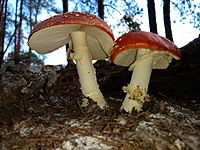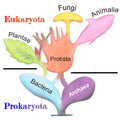
Back بوابة:فطريات Arabic Portál:Houby Czech Portail:Mycologie French Portale:Micologia Italian Vikisritis:Grybai Lithuanian Portaal:Schimmels Dutch Portal:Micologia Portuguese Портал:Микология Russian Портал:Гөмбәләр Tatar Portal:真菌 Chinese
The Fungi Portal
A fungus is any member of a large group of eukaryotic organisms that includes microorganisms such as yeasts and molds, as well as the more familiar mushrooms. The Fungi are classified as a kingdom that is separate from plants and animals. The discipline of biology devoted to the study of fungi is known as mycology or fungal biology, which is historically regarded as a branch of botany, even though genetic studies have shown that fungi are more closely related to animals than to plants. Fungi reproduce via spores and grow as hyphae, mycelia, and further specialized structures. Fungal spores are often produced on specialized structures or in fruiting bodies, such as the head of a mushroom. Abundant worldwide, most fungi are mostly invisible to the naked eye because of the small size of their structures, and their cryptic lifestyles in soil, on dead matter, and as symbionts of plants, animals, or other fungi. Fungi perform an essential role in the decomposition of organic matter and have fundamental roles in nutrient cycling and exchange. They have long been used as a direct source of food, such as mushrooms and truffles, as a leavening agent for bread, and in fermentation of various food products, such as wine, beer, and soy sauce.
Since the 1940s, fungi have been used for the production of antibiotics, and, more recently, various enzymes produced by fungi are used industrially and in detergents. Fungi are also used as biological agents to control weeds and pests. Many species produce bioactive compounds called mycotoxins, such as alkaloids and polyketides, that are toxic to animals including humans. The fruiting structures of a few species are consumed recreationally or in traditional ceremonies as a source of psychotropic compounds. Fungi can break down manufactured materials and buildings, and become significant pathogens of humans and other animals. Losses of crops due to fungal diseases or food spoilage can have a large impact on human food supplies and local economies. Despite their importance on human affairs, little is known of the true biodiversity of Kingdom Fungi, which has been estimated at around 1.5 million species, with about 5% of these having been formally classified.
| More about fungi... |
Selected article
The small, tough, fruit bodies are grayish-brown balls that are initially enclosed by a skin, or peridium, made up of four distinct layers of tissue. The outer tissue layer splits to form star-like rays and expose a circular spore case. Inside the spore case is the gleba—fertile spore-producing tissue that is white and firm when young, but becomes brown and powdery in age. The grayish-brown spore case is set on a short, slender stalk, and has a well-defined narrow pore at the top where mature spores may escape. Fully expanded, the fruit body reaches dimensions up to 2–3 cm (0.8–1.2 in) wide and up to about 3 cm (1.2 in) tall. The outer skin is purplish-brown, with four or five cream or yellowish-brown colored rays that have their tips stuck in the substrate. There is a flat mat of interwoven mycelia between ray tips. The spores are spherical, warty, and have a diameter of up to 6 µm. Geastrum quadrifidum is one of a number of earthstars whose rays arch downward as they mature, lifting the spore sac upward, high enough to catch air currents that disseminate the spores into new habitats. The species is easily confused with Geastrum fornicatum, a larger earthstar without a well-defined pore mouth.
Selected species
Originally described from the Sierra Nevada, C. sculpta is found in mountainous areas in western North America, and was first recorded from a Brazilian dune in 2008. It may be easily confused with Calbovista subsculpta, a similar puffball which—in addition to differences observable only with microscopy—is larger, and has slightly raised felty warts. Other similar species include Calvatia arctica and immature specimens of Amanita magniverrucata.
Things to do
If you want to help Wikipedia to improve its coverage of fungi, here are some things you can do...
- Assess some fungi articles.
- Join Wikipedia:WikiProject Fungi or ask on the talk page.
- Join the lichen task force.
- Review, improve, expand or clean some of the newly created fungi-related articles.
- Expand some high priority fungus stubs.
- Expand or sort other fungi-related stubs.
- Add images to articles in the list of unillustrated fungi articles, or add more articles to the list.
- Write fungi-related articles from scratch. For ideas of needed articles, see the redlinks on-
- Review the fungi articles flagged as needing attention.
WikiProjects
WikiProjects related to fungi:
Selected picture
Did you know?
- ... that species in the fungal genus Wynnea (W. americana, pictured) have asci that are capped by a hinged operculum?
- ... that species in the fungal genus Ameliella have been found in the Skibotn area in central Northern Norway, a hotspot of lichen species diversity?
- ... that upon coming in contact with an alkali solution, the hairs of the fungus Microstoma floccosum will swell and then dissolve?
- ... that the grisette is enjoyed by cows?
- ... that the yellow earth tongue has been described as a fungus one is likely to find while looking for something else?
General images -
Related portals
Topics
- Main topics lists: Outline of fungi and Outline of lichens
- Fungi: Bracket fungus, carnivorous fungus, coprophilous fungi, entomopathogenic fungus, evolution of fungi, lichen, mushroom, mycology (lichenology, mycotoxicology, paleomycology), mycorrhiza, pathogenic fungi, puffball, wood-decay fungus
- Fungal orders: Chytridiomycota, Blastocladiomycota, Neocallimastigomycota, Zygomycota, Glomeromycota. Dikarya: Ascomycota, Basidiomycota
- Fungi lists: Species: Agaricus species, Amanita species, Boletus species, Cortinarius species, Cyathus species, Hygrocybe species, Hygrophorus species, Inocybe species, Lactarius species, Mycosphaerella species, Panaeolus species, Psilocybe species, Russula species, Scleroderma species Other lists: Mycology journals, psilocybin mushrooms
- Uses: Edible mushroom, mushroom poisoning, psilocybin mushrooms, mushroom hunting, fungiculture, fermentation, baker's yeast, mycoremediation, lichenometry, mushroom dye
Categories
© MMXXIII Rich X Search. We shall prevail. All rights reserved. Rich X Search











![Image 7Pennate diatom from an Arctic meltpond, infected with two chytrid-like [zoo-]sporangium fungal pathogens (in false-colour red). Scale bar = 10 μm. (from Marine fungi)](http://upload.wikimedia.org/wikipedia/commons/thumb/b/b5/Pennate_diatom_infected_with_two_chytrid-like_fungal_pathogens.png/120px-Pennate_diatom_infected_with_two_chytrid-like_fungal_pathogens.png)




















































